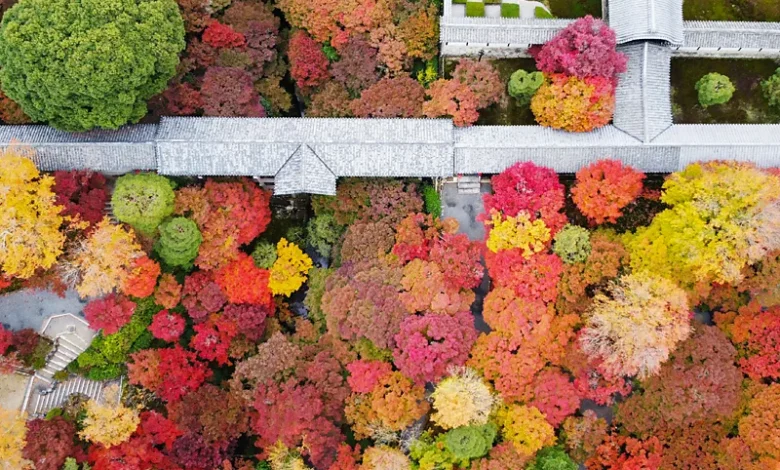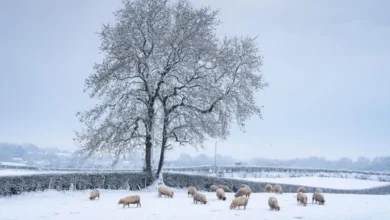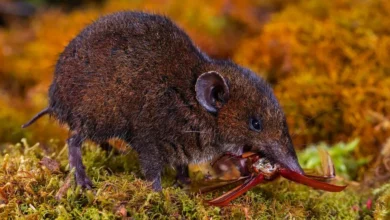The mystery of why leaves change colour in the autumn

Although the chemistry of autumn colours is well understood, there is an ongoing and lively debate among scientists about why trees evolved their vivid autumn colours in the first place.
Driving north through Duchess County, New York, in mid-October, I’m flanked by the resplendent golden yellows and fiery red leaves. The pops of colour break open like fireworks when the sunlight dapples across the leaves. It’s a harbinger that colder months lie ahead.
Further north in Maine, the colours are far more muted. “In a fall like this one, we have some plants that are [changing] really early and undergoing senescence really quickly because they’re drought-stressed,” says Amanda Gallinat, an ecologist who studies changes in seasonal events in the natural world at Colby College in Waterville, Maine. When she looks out of her window, she sees a lot of leaves turning brown already.
On the other side of the Atlantic Ocean, similar colour changes occur every autumn in the UK. Here, however, there are far more yellows than reds, due to the dominant species of native deciduous trees – beech, sycamore and oak. “In the UK, the most colourful ones are usually introduced species,” says David Wilkinson, an evolutionary ecologist at the University of Lincoln in the UK. Sumach, for example, produces a vivid red, but species of these small trees are native to the Mediterranean, parts of Asia and North America.
Meanwhile, in Japan, the fiery red, purple and yellow shades of the maple transform the landscape and draw tourists by their many thousands. In many parts of the world, “leaf peeping” has become a popular attraction as millions travel to see and photograph the spectacular seasonal shifts in leaf colour.
Yet, despite receiving so much attention, we still don’t really know why trees undergo this transformation in the first place.
While biologists have a clear understanding of the biochemistry that causes the green to drain out of leaves with the change of the seasons to leave such vivid colours left behind, what led deciduous trees to evolve their autumn colours is still a mystery.

A lively academic debate has, in fact, been raging about this very issue for decades. Read on to find out about some of the leading theories.
First, however, it’s important to understand what is going on in leaves when they change colour.
Leaves that turn yellow were actually always yellow – the colour comes from a set of biochemical pigments known as carotenoids. These are simply revealed once the green chlorophyll in the leaves breaks down and the nutrients are reabsorbed by the plants as they prepare to hunker down for the harsh winter weather.
Leaves that turn red or purple undergo a slightly different process: their colour stems from a combination of chlorophyll loss and the production of anthocyanins, which are commonly found in many fruits and vegetables too.
In evolutionary biology, however, the fact that these annual changes have persisted in tree species around the world against the ravages of time and natural selection suggests that it may confer some benefit to the trees. Indeed, genetic research has suggested that trees only began producing the pigments responsible for the autumn colours comparatively late in their evolution – long after they began reabsorbing their chlorophyll.
Complicating all of this is that some species of trees will produce multiple different autumn leaf colours, and sometimes more than one colour will appear on a single tree. One thing is for certain, that once the leaves change colour, they will fall from the branches within days or weeks.
One leading theory proposes that red leaf colour may have co-evolved alongside pests, acting as a defensive signal to ward off insects.
Another of the main theories for why this might be is the photoprotection theory. This is the idea that the pigments act as a kind of sunscreen for the leaves during a vulnerable stage of metamorphosis. Anthocyanins are potent antioxidants, which are thought to protect leaves against damage from sunlight as they deteriorate with age, a process known as senescence. This theory seems to make sense for a number of different plant species, such as the red osier dogwood.
This photoprotection theory has gained some credence due to research that has revealed sunlight can be more damaging to leaves during autumn in the Northern Hemisphere.
“Colour change is really a northern hemisphere phenomenon,” says Susanne Renner, an evolutionary biologist at Washington University in St Louis, US, who co-authored the study. “Even in the northern hemisphere, relatively few species change colour.”
One analysis of 2,368 species of deciduous trees in temperate regions of the world found 290 turn red while 378 turn yellow. It also concluded that the red autumn colours appear to have evolved independently at least 25 times, while yellow colours evolved 28 times – lending more support to the idea that these colours serve a distinct and beneficial purpose for trees.
The majority of tree species with red autumn leaves are found in eastern North America and East Asia. At least 89 species, according to some estimates, turn red in North America while 152 are known to in East Asia. Northern Europe, by comparison, has just 24 species that produce red colours.

It would be easy to assume that the pattern of red-leaf occurrence perhaps follows simple differences in temperature. Some research, however, has suggested that the levels of solar radiation are higher in North America and East Asia than in Europe. Renner’s research suggests that a combination of higher radiation, abrupt fluctuations in temperature and a shorter growing season may explain why eastern North America’s autumn colours are particularly brightly coloured. Essentially, it gives the trees there more time to reabsorb the nutrients from their leaves before they drop. This is because without the chlorophyll, the light can trigger oxidative stress in the leaves that can cause their cells to die.
“It’s called reactive oxygen damage,” says Renner. “Eastern North America, in September and October, has a lot of light coming in, and that would put a higher selective pressure on putting on the sunscreen.”
Anthocyanins help to block and refract this harmful sunlight, giving trees that produce them vital protection in the final months before winter. Carotenoids in yellow leaves also provide this benefit, though not nearly as well as red leaves.
But the idea is still contested. “There is no one photoprotection study that shows the answer unambiguously,” says Wilkinson. “Our understanding is instead based on multiple studies tending to suggest the same thing.”
A 2004 study also suggests that a tree can produce more anthocyanins at colder temperatures or during periods of more frequent cold snaps during the autumn senescence. This would seem to suggest that anthocyanins also play a role in helping to shield leaves from the cold and frost.
The insect co-evolution theory, by comparison, suggests that trees have evolved to change their leaf colours as a warning to deciduous leaf-eating insects, such as aphids.
Aphids are destructive creatures, and an infestation could do significant harm to a tree, so the idea of it using colour to ward off these insects seems plausible. But several academic papers over the years have contested this theory.
A major crack in the argument is how aphids see and respond to colour. Aphids, along with other leaf-eating insects such as locusts and caterpillars, do not possess receptors in their eyes that enable them to perceive the colour red the way humans do. To them, it looks dull, grey, or even black.

Some have suggested that aphids may avoid red leaves simply because they appear to be dead or dying, and so are a poor source of food or a place to lay their eggs. Experts refer to this as the camouflage theory. It’s purportedly an “honest” signal, but red pigments are also costly for the tree to produce in terms of energy and resources.
Yellow has also been shown to be a powerful attractant to insects like aphids – it triggers the same receptors in their eyes that see green. Interestingly, WD Hamilton, the scientist who posthumously published the original paper on the co-evolution theory, found that more leaf yellowness was positively correlated with increased aphid colonisation.
Considering all this, Renner does not believe the co-evolution theory holds water. Gallinat, however, isn’t so sure. “Some of those findings that support that hypothesis, I think, are still pretty reasonable.”
Wilkinson posits that both theories could be viable. “There is no good reason to think it must be photoprotection or signalling. It’s possible that both could be involved.”










